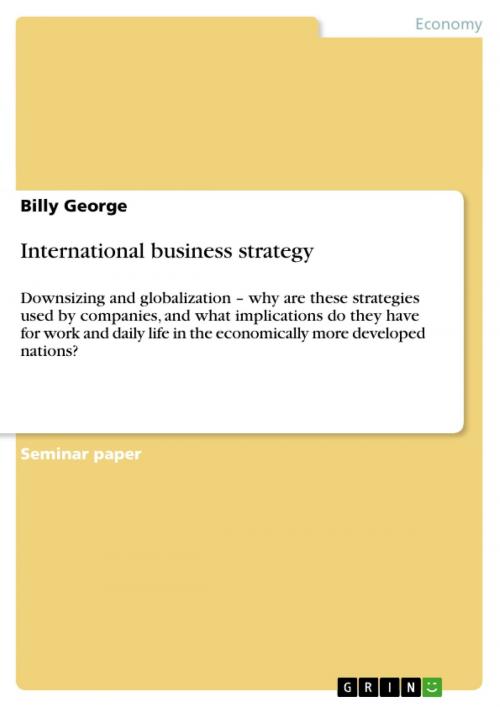International business strategy
Downsizing and globalization - why are these strategies used by companies, and what implications do they have for work and daily life in the economically more developed nations?
Business & Finance, Management & Leadership, Operations Research| Author: | Billy George | ISBN: | 9783656615217 |
| Publisher: | GRIN Verlag | Publication: | March 14, 2014 |
| Imprint: | GRIN Verlag | Language: | English |
| Author: | Billy George |
| ISBN: | 9783656615217 |
| Publisher: | GRIN Verlag |
| Publication: | March 14, 2014 |
| Imprint: | GRIN Verlag |
| Language: | English |
Seminar paper from the year 2012 in the subject Business economics - Operations Research, grade: A, Monash University Melbourne, language: English, abstract: Strategy is the choice of direction and scope that a firm takes on a long term and involves the configuration of the firm status with a view to enjoy the advantages that come with the changes; however this requires the changing of the present environment in order to fit the needs of the new environment (Wilson, 2002). Types of strategic changes Converging (fine tuning): this type of change involves trying to enhance the status of a situation; it is mainly done at departmental level and involves reorganization in order to ensure that the resources available and an introduced process fit each other (Lawler, 2004). Converging (increment adaptation): The changes done are small; they aim at adjusting the organization to small changes in a business environment (Lawler, 2004). The changes are done in bits and the process is therefore slow. Discontinuous/ frame-breaking: the changes are major and heavy in that they take time to plan and for full implementation to be realized, they take over 18-24 months. Examples of frame-breaking changes include changes in power shift, workflow procedures, and a complete reorganization of a firm. The changes are either modular or corporate transformations (French & Bell, 2008). They are the major changes; modular transformation involves reorganizing several departments, or downsizing. Corporate transformation is also major and affects every department in the organization (French & Bell, 2008).
Seminar paper from the year 2012 in the subject Business economics - Operations Research, grade: A, Monash University Melbourne, language: English, abstract: Strategy is the choice of direction and scope that a firm takes on a long term and involves the configuration of the firm status with a view to enjoy the advantages that come with the changes; however this requires the changing of the present environment in order to fit the needs of the new environment (Wilson, 2002). Types of strategic changes Converging (fine tuning): this type of change involves trying to enhance the status of a situation; it is mainly done at departmental level and involves reorganization in order to ensure that the resources available and an introduced process fit each other (Lawler, 2004). Converging (increment adaptation): The changes done are small; they aim at adjusting the organization to small changes in a business environment (Lawler, 2004). The changes are done in bits and the process is therefore slow. Discontinuous/ frame-breaking: the changes are major and heavy in that they take time to plan and for full implementation to be realized, they take over 18-24 months. Examples of frame-breaking changes include changes in power shift, workflow procedures, and a complete reorganization of a firm. The changes are either modular or corporate transformations (French & Bell, 2008). They are the major changes; modular transformation involves reorganizing several departments, or downsizing. Corporate transformation is also major and affects every department in the organization (French & Bell, 2008).















